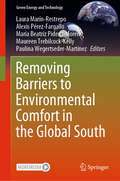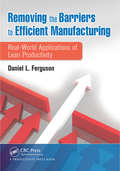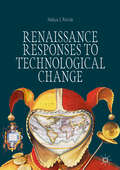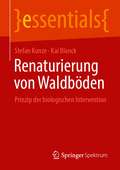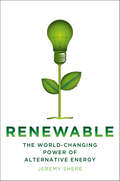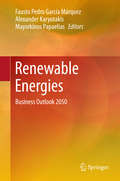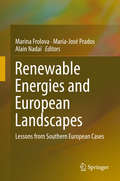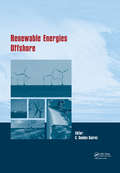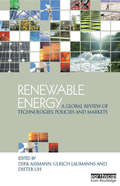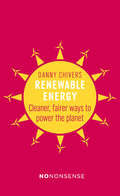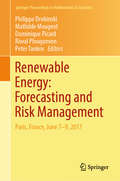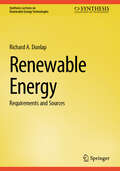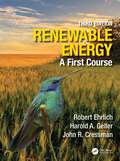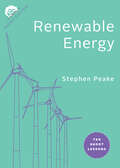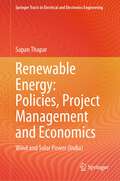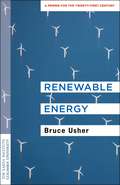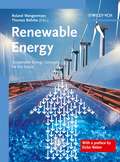- Table View
- List View
Removing Barriers to Environmental Comfort in the Global South (Green Energy and Technology)
by Laura Marín-Restrepo Alexis Pérez-Fargallo María Beatriz Piderit-Moreno Maureen Trebilcock-Kelly Paulina Wegertseder-MartínezThis book describes how comfort, energy and climate change in developing countries and vulnerable sectors of the population relate to buildings.The building sector is currently facing significant challenges connected to energy consumption, energy poverty and climate change effects. When studied in developing countries and vulnerable sectors of the population, these factors, which are commonplace in the tropics and the southern hemisphere, are interlinked and share a critical component: environmental comfort. Although progress has been made in environmental comfort through research and the development of standards and policies at the international level, in the Global South, where the countries with the highest levels of income inequality are concentrated, environmental comfort has its own characteristics and challenges that prevent a clear understanding from the established vision of the Global North.This book presents research, theories and techniques related to Thermal comfort, Indoor air quality, Visual comfort, and Acoustic comfort and its relationship with energy use and energy efficiency, seeking to address different barriers to environmental comfort. It shows how to improve the way buildings are designed and operated to promote healthier environmental conditions and more sustainable construction, by presenting studies and reflections carried out in the target geographical area: the Global South. In this way, this book contributes to developing the concept of environmental comfort, visualising how progress has been made in understanding it from a tropical and southern perspective, and posing common challenges.The book is intended for engineers, architects, and researchers of the built environment who are interested in environmental comfort and its influence on energy consumption, energy poverty, and other related factors in the Global South context. It is also a useful resource for decision-makers and public policy developers concerned with the indoor comfort of buildings. Moreover, the book aims to provide guidance for those in developing countries by gathering existing knowledge in the field for the tropics and southern hemisphere climatic and sociocultural contexts, allowing us to move forward in this subject with actions and proposed solutions that fit our particular needs.
Removing the Barriers to Efficient Manufacturing: Real-World Applications of Lean Productivity
by Daniel L. FergusonW. Edwards Deming‘s central premise was that improvements in product quality would increase productivity, improve competitive position, and help ensure long-term survival. Point 12 of his landmark 14 Points for Management says that management‘s job is to remove the barriers that keep people from taking pride in their work. That‘s exactly what this book is about.Shedding new light on Deming‘s 14 Points, Removing the Barriers to Efficient Manufacturing: Real-World Applications of Lean Productivity outlines time-tested organizational structures and methods to help you reduce variability and deliver high-quality products consistently. It describes the financial losses that can occur as a result of variability and details the specific activities management must engage in to avoid these losses and ensure long-term success.Instead of taking you on a random walk, the book supplies each manufacturing group in your organization with straightforward directions for creating a smooth-running facility with reduced variability. It includes work assignments in each chapter that, if completed in the order presented, will guide you through the creation of the Model Vision for your manufacturing facility. It also:Covers key topics on working with people, including training and retrainingSupplies pointers for working with unions Considers Single Minute Exchange of Die (SMED)Describes how to put it all together with action plansThe book includes a write up on Deming‘s famous Red Bead Experiment as well as an introduction to statistical process control techniques in the appendices. Filled with real-world examples and a case study to illustrate essential concepts, the book arms you with the insight and common-sense approaches required to build on Deming‘s fundamental principles and consistently deliver high-quality pr
Remya Jose's Great Idea (Fountas & Pinnell LLI Red #Level L)
by Sunita ApteMEET REMYA JOSE, TEEN MENTOR For Remya, a busy 14-year-old, there just weren't enough hours in the day. Lots of teens face the same problem. But how many solve it with a new invention?
The Renaissance of Renewable Energy
by Gian Andrea Pagnoni Stephen RocheThis book provides detailed yet easily understandable information about sustainable energy alternatives in the context of growing public concern about climate change, the impending fuel crisis and environmental degradation. It deals with the history of energy use and the factors that have led to the current interest in energy alternatives and assesses the chance of renewable energy replacing fossil fuels in the future. The authors manage to make a highly complex and often intimidating subject not only accessible but also engaging and entertaining. This book unpacks but never simplifies the science of energy, leavening the more technical passages with anecdotes, metaphors, examples and imagery. By also dealing with the history, politics and economics of energy use, it offers both scientific and non-scientific readers a deeper understanding of the most important issue of our age.
Renaissance Responses to Technological Change
by Sheila J. NayarThis book foregrounds the pressures that three transformative technologies in the long sixteenth century—the printing press, gunpowder, and the magnetic compass—placed on long-held literary practices, as well as on cultural and social structures. Sheila J. Nayar disinters the clash between humanist drives and print culture; places the rise of gunpowder warfare beside the equivalent rise in chivalric romance; and illustrates fraught attempts by humanists to hold on to classicist traditions in the face of seismic changes in navigation. Lively and engaging, this study illuminates not only how literature responded to radical technological changes, but also how literature was sometimes forced, through unanticipated destabilizations, to reimagine itself. By tracing the early modern human’s inter-animation with print, powder, and compass, Nayar exposes how these technologies assisted in producing new ways of seeing, knowing, and being in the world.
Renaturierung von Waldböden: Prinzip der biologischen Intervention (essentials)
by Stefan Kunze Kai BlanckDas Buch zeigt Wege, Wälder gegen Trockenheit und Klimawandel zu stabilisieren. Der Waldboden muss dazu viel stärker beachtet und durch biologische Maßnahmen gestärkt werden. Gerade auf sauren, nährstoffarmen Standorten, wo Fichten und Kiefern in Monokulturen wachsen, führt das punktuelle Einbringen von Biokompost zum Rückgang der Versauerung und damit zur Revitalisierung von Boden und Pflanzen. Die über Jahre erprobte „Biologische Intervention“ gibt den Bäumen neue Kraft, die sie zukünftig brauchen. Die Humusanreicherung bringt mehr Leben in den Boden. Nur ein gesunder Boden kann gesunde Bäume tragen.
Renewable: The World-Changing Power of Alternative Energy
by Jeremy ShereWhere does the energy we use come from? It's absolutely vital to every single thing we do every day, but for most people, it is utterly invisible. Flick a switch and the lights go on. It might as well be magic. Science writer Jeremy Shere shows us in Renewable: The World-Changing Powerof Alternative Energy that energy is anything but magical. Producing it in fossil fuel form is a dirty, expensive—but also hugely profitable— enterprise, with enormous but largely hidden costs to the entire planet. The cold, hard fact is that at some point we will have wrung the planet dry of easily accessible sources of fossil fuel. And when that time comes, humankind will have no choice but to turn—or, more accurately, return—to other, cleaner, renewable energy sources. What will those sources be? How far have we come to realizing the technologies that will make these sources available?To find the answers, Shere began his journey with a tour of a traditional coal-fueled power plant in his home state of Indiana. He then continued on, traveling from coast to coast as he spoke to scientists, scholars and innovators. He immersed himself in the green energy world: visiting a solar farm at Denver's airport, attending the Wind Power Expo and a wind farm tour in Texas, investigating turbines deep in New York City's East River, and much more. Arranged in five parts—Green Gas, Sun, Wind, Earth, and Water—Renewable tells the stories of the most interesting and promising types of renewable energy: namely, biofuel, solar, wind, geothermal, and hydropower. But unlike many books about alternative energy, Renewable is not obsessed with megawatts and tips for building home solar panels. Instead, Shere digs into the rich, surprisingly long histories of these technologies, bringing to life the pioneering scientists, inventors, and visionaries who blazed the way for solar, wind, hydro, and other forms of renewable power, and unearthing the curious involvement of great thinkers like Henry Ford, Thomas Edison, and Nicola Tesla.We are at an important crossroads in the history of renewable technologies. The possibilities are endless and enticing, and it has become increasingly clear that renewable energy is the way of the future. In Renewable, Jeremy Shere's natural curiosity and serious research come together in an entertaining and informative guide to where renewable energy has been, where it is today, and where it's heading.
Renewable and Efficient Electric Power Systems
by Gilbert M. MastersA solid, quantitative, practical introduction to a wide range of renewable energy systems-in a completely updated, new edition The second edition of Renewable and Efficient Electric Power Systems provides a solid, quantitative, practical introduction to a wide range of renewable energy systems. For each topic, essential theoretical background is introduced, practical engineering considerations associated with designing systems and predicting their performance are provided, and methods for evaluating the economics of these systems are presented. While the book focuses on the fastest growing, most promising wind and solar technologies, new material on tidal and wave power, small-scale hydroelectric power, geothermal and biomass systems is introduced. Both supply-side and demand-side technologies are blended in the final chapter, which introduces the emerging smart grid. As the fraction of our power generated by renewable resources increases, the role of demand-side management in helping maintain grid balance is explored. Renewable energy systems have become mainstream technologies and are now, literally, big business. Throughout this edition, more depth has been provided on the financial analysis of large-scale conventional and renewable energy projects. While grid-connected systems dominate the market today, off-grid systems are beginning to have a significant impact on emerging economies where electricity is a scarce commodity. Considerable attention is paid to the economics of all of these systems. This edition has been completely rewritten, updated, and reorganized. New material has been presented both in the form of new topics as well as in greater depth in some areas. The section on the fundamentals of electric power has been enhanced, making this edition a much better bridge to the more advanced courses in power that are returning to many electrical engineering programs. This includes an introduction to phasor notation, more emphasis on reactive power as well as real power, more on power converter and inverter electronics, and more material on generator technologies. Realizing that many students, as well as professionals, in this increasingly important field may have modest electrical engineering backgrounds, early chapters develop the skills and knowledge necessary to understand these important topics without the need for supplementary materials. With numerous completely worked examples throughout, the book has been designed to encourage self-instruction. The book includes worked examples for virtually every topic that lends itself to quantitative analysis. Each chapter ends with a problem set that provides additional practice. This is an essential resource for a mixed audience of engineering and other technology-focused individuals.
Renewable and Efficient Electric Power Systems (Ieee Press Ser.)
by Gilbert M. Masters Kevin F. HsuRENEWABLE AND EFFICIENT ELECTRIC POWER SYSTEMS Join the energy revolution—this comprehensive resource offers quantitative and practical approaches for designing a sustainable, 21st-century electricity system, covering renewable generation technologies, conventional power plants, energy efficiency, storage, and microgrids. Renewable and Efficient Electric Power Systems dives into the fundamentals of modern electricity systems, introducing key technologies, economic and environmental impacts, and practical considerations for energy and climate professionals. The book explains the science and engineering underlying renewable energy—including solar, wind, and hydropower—along with an expanded set of key energy technologies such as fuel cells, batteries, and hydrogen. This updated edition prepares readers to participate in the world’s ongoing efforts to decarbonize the electricity sector and move toward a more sustainable future. The book covers foundational knowledge of electric power, up through current developments and future prospects for renewable energy. The update significantly expands core content to address topics such as energy efficiency, smart grids, energy storage, and microgrids. It reframes energy as an integral factor in urban development and highlights forward-looking strategies to decarbonize the built environment. The text draws on a multi-scalar approach that ranges from utility-scale to building-scale to assess energy systems, and further considers centralized vs. distributed system architecture. The authors integrate perspectives from engineering professionals across different sectors, incorporating relevant insights from applied projects, with an eye toward implementing energy systems in the real world. Given the textbook’s broad reach, this edition situates energy development in an international context and provides examples relevant to a global audience. An essential resource for engineers and other practitioners working in climate and energy, offering cutting-edge frameworks and quantitative approaches to energy system design. Early chapters develop the skills and knowledge necessary for students and professionals entering the clean energy field. Later chapters offer an excellent bridge to prepare advanced students for further study in power engineering, or who intend to pursue policy or economic analysis. Step-by-step explanations of quantitative analysis are supplemented with additional practice problems to encourage self-instruction or complement classroom use. Accessible explanations provide planners and policymakers with fundamental technical understanding of energy systems. Combines pure technical analysis with economic and environmental considerations, and explores the link between energy, carbon, and new digital technologies, to provide a more comprehensive approach to energy education. As the world undergoes a transformation in energy and electricity, Renewable and Efficient Electric Power Systems is an indispensable text for students of energy, environment, and climate, as well as for practitioners seeking to refresh their understanding of renewable energy systems.
Renewable and Sustainable Materials in Green Technology (SpringerBriefs in Applied Sciences and Technology)
by Mohd Firdaus Yhaya Husnul Azan Tajarudin Mardiana Idayu AhmadThis book discusses recent developments in renewable and sustainable materials from a green technology perspective and how these materials interact with the environment. It highlights the fundamental processes involved in the production of renewable and sustainable materials, including chemical and biological approaches as well as these materials’ potential application as green technological option. Written in a didactic style, it offers a guide and insights into renewable and sustainable materials. Each chapter provides in-depth technical information on the material’s theory and its applications. The book shows how new materials may help us solve human and environmental issues in the future and suggests where current research may lead.
Renewable Biofuels
by Diwakar Rana Vandana RanaThis book offers a complete introduction for novices to understand key concepts of biocatalysis and how to produce in-house enzymes that can be used for low-cost biofuels production. The authors discuss the challenges involved in the commercialization of the biofuel industry, given the expense of commercial enzymes used for lignocellulose conversion. They describe the limitations in the process, such as complexity of lignocellulose structure, different microbial communities' actions and interactions for degrading the recalcitrant structure of lignocellulosic materials, hydrolysis mechanism and potential for bio refinery. Readers will gain understanding of the key concepts of microbial catalysis of lignocellulosic biomass, process complexities and selection of microbes for catalysis or genetic engineering to improve the production of bioethanol or biofuel
Renewable Electricity and the Grid: The Challenge of Variability
by Godfrey Boyle?Integrating intermittent renewable energy sources like wind into electricity systems must be one of the most misunderstood issues in energy policy. This edited volume brings together a unique series of authoritative articles on the topic. There should be no excuse for misunderstanding from now on.? JIM SKEA, RESEARCH DIRECTOR, UK ENERGY RESEARCH CENTRE ?The future design and operation of electric power systems with large injections of renewable energy generation is the subject of much debate, and some misunderstanding. This timely book, from a number of authors with expertise in the area, makes an important contribution to our understanding of this topic.? NICK JENKINS, PROFESSOR OF ENERGY SYSTEMS, UNIVERSITY OF MANCHESTER ?We know the future will be different from the past. This book predicts how large proportions of renewable energy can be incorporated into electricity grids, without harm from the natural variability of these supplies. The chapter authors have different approaches and vision, yet the overall message is positive. Not only can we move to dominant use of renewable electricity, but we can do so utilizing many technological and efficiency improvements, with consumers benefiting from clean electricity at acceptable cost.? PROFESSOR JOHN TWIDELL, GENERAL EDITOR, WIND ENGINEERING 'Anyone interested in renewable electricity will find this book an important reference. It answers many of teh questions so often raised in public debates' Sherkin Comment Can renewable energy provide reliable power? Will it need extensive backup? The energy available from wind, waves, tides and the sun varies in ways that may not match variations in energy demand. Assimilating these fluctuations can affect the operation and economics of electricity networks, markets and the output of other forms of generation. Is this a significant problem, or can these new sources be integrated into the grid system without the need for extensive backup or energy storage capacity? This book examines the significance of the issue of variability of renewable electricity supplies, and presents technical and operational solutions to the problem of reconciling the differing patterns of supply and demand. Its chapters are authored by leading experts in the field, who aim to explain and quantify the impacts of variability in renewable energy, and in doing so, dispel many of the myths and misunderstandings surrounding the topic.
Renewable Energies
by Fausto Pedro García Márquez Alexander Karyotakis Mayorkinos PapaeliasThis book provides a comprehensive overview of current renewable energy technologies and their basic principles. It also addresses the financial aspects of renewable energy projects and analyzes their profitability, covering the most relevant topics for engineers, economists, managers and scientists who are actively involved in renewable energy research and management. The authors are professionals and researchers who are active in the industry, and supplement the main content with revealing case studies and best-practice examples.
Renewable Energies and European Landscapes
by Marina Frolova María-José Prados Alain NadaïThis book provides timely, multidisciplinary cross-national comparison of the institutional and social processes through which renewable energy landscapes have emerged in Southern Europe. On the basis of case studies in these countries, it analyzes the way in which and the extent to which the development of renewable energies has affected landscape forms and whether or not it has contributed to a reformulation of landscape practices and values in these countries. Landscape is conceived broadly, as a material, social, political and historical process embedded into the local realm, going beyond aesthetic. The case studies analyze renewable energy landscapes in Southern Europe on different political and geographical scales and compare different types of renewable energy such as wind, hydro, solar and biomass power. The contributors are leading experts from Spain, France, Italy and Portugal. The book is intended for researchers, graduate students and professionals interested in geography, landscape and planning.
Renewable Energies Offshore
by C. Guedes SoaresRenewable Energies Offshore includes the papers presented in the 1st International Conference on Renewable Energies Offshore (RENEW2014), held in Lisbon, 24-26 November 2014. The conference is a consequence of the importance of the offshore renewable energies worldwide and an opportunity to contribute to the exchange of information on the dev
Renewable Energy: A Global Review of Technologies, Policies and Markets
by Dirk A Ulrich Laumanns Dieter Uh'offers knowledge and inspiration to promote renewable energy in developing and industrialized countries' Klaus Toepfer, Executive Director of UNEP From technology to financing issues, Renewable Energy offers a comprehensive and authoritative review of the determining factors that drive worldwide dissemination of renewable energy technologies. With a clear emphasis on policy and action, contributions from internationally renowned experts combine to form a holistic picture of the current status, impacts and future potential of renewable energy. Addressing the situation in both developing and developed countries, each chapter reviews in detail a different issue, to present extensive information on social, environmental, political, economic and technological aspects. This will be essential reading for professionals in renewable energy, in particular policy-makers, researchers, NGOs and energy consultants, and a valuable resource for teachers and students of renewable energy, environmental studies, development studies, political science and international relations.
Renewable Energy: Cleaner, fairer ways to power the planet (No-Nonsense Guides #35)
by Danny ChiversFew people doubt the threat of climate change and the urgent need to conquer fossil fuel addiction. But can renewable sources of energy ever be sufficient to provide modern societies with a decent quality of life? This book is clear. They can. And it outlines the strategies to break the barriers to a 100% renewable world. Danny Chivers presents a compelling introduction to renewable technologies for non-technical readers (solar, wind, hydro, geothermal and ambient heat, wave and tidal, fuel crops, and energy from waste) and a roadmap to powering the world, not just sustainably, but democratically.
Renewable Energy: Paris, France, June 7-9, 2017 (Springer Proceedings in Mathematics & Statistics #254)
by Philippe Drobinski Mathilde Mougeot Dominique Picard Riwal Plougonven Peter TankovGathering selected, revised and extended contributions from the conference ‘Forecasting and Risk Management for Renewable Energy FOREWER’, which took place in Paris in June 2017, this book focuses on the applications of statistics to the risk management and forecasting problems arising in the renewable energy industry. The different contributions explore all aspects of the energy production chain: forecasting and probabilistic modelling of renewable resources, including probabilistic forecasting approaches; modelling and forecasting of wind and solar power production; prediction of electricity demand; optimal operation of microgrids involving renewable production; and finally the effect of renewable production on electricity market prices. Written by experts in statistics, probability, risk management, economics and electrical engineering, this multidisciplinary volume will serve as a reference on renewable energy risk management and at the same time as a source of inspiration for statisticians and probabilists aiming to work on energy-related problems.
Renewable Energy: Requirements and Sources (Synthesis Lectures on Renewable Energy Technologies)
by Richard A. DunlapThe transition to renewable energy is essential for ensuring energy supply, and to mitigate environmental effects of fossil fuels, particularly climate change. However, because renewable energy resources do not provide a constant supply of energy and they are not sufficiently portable for many applications, the development of energy storage methods is necessary. The book reviews historical and current energy use, as well as provides predictions for future energy demands. The main sources of renewable energy are introduced including hydroelectric, wind, solar, geothermal, and biofuels, along with an analysis of the need for energy storage.
Renewable Energy: A First Course (Second Edition)
by Robert Ehrlich Harold A. Geller<p>This revised edition is fully updated and continues to provide the best in-depth introduction to renewable energy science. It focuses mainly on renewable energy, but also addresses nonrenewable energy (fossil fuels and nuclear technology). The coverage extends from the basic physics to conservation, economic, and public policy issues, with strong emphasis on explaining how things work in practice. <p>The authors avoid technical jargon and advanced math, but address fundamental analytical skills with wide application, including: <p> <li>Two brand new chapters giving an introduction to population dynamics and statistical analysis for energy studies Additional self-study problems and answers <li>More worked examples <li>Up-to-date coverage of areas such as hydraulic fracturing, integration of renewable energy to power grid, and cost.</li> </p>
Renewable Energy: A First Course
by Robert Ehrlich Harold A. Geller John R. CressmanThis revised edition of Renewable Energy: A First Course is fully updated and continues to provide the best in-depth introduction to renewable energy science. The book focuses mainly on renewable energy, but also addresses nonrenewable energy (fossil fuels and nuclear technology). The coverage extends from the basic physics to conservation, economic, and public policy issues, with strong emphasis on explaining how things work in practice. The authors avoid technical jargon and advanced math but address fundamental analytical skills with wide application. Updated statistics, figures, policies, trends, and technological advancements will bring the reader up to speed with the current state of renewable energy.
Renewable Energy: Ten Short Lessons (Pocket Einstein Series)
by Stephen PeakeAn expert introduction to the fascinating world of renewable energy and the transition from fossil fuels to clean energy that lies at the heart of a brighter climate future.In Renewable Energy: Ten Short Lessons, Stephen Peake distills the key issues of this timely subject, examining how we can harness the power of a range of groundbreaking energy technologies most effectively to achieve a sustainable energy future. Renewable energy is central to managing climate change and our transition to a sustainable energy supply for the 10 billion of us who will populate the earth by 2050. But how will we cope without fossil fuels to heat, cool, and light our buildings, power our industry, and run our transport systems? And are some renewables better than others? Packed full of easy-to-understand diagrams and fact boxes, these ten lessons cover all the basics, as well as the latest understanding and developments, to enlighten the nonscientist. About the series: The Pocket Einstein series is a collection of essential pocket-sized guides for anyone looking to understand a little more about some of the most important and fascinating areas of science in the twenty-first century. Broken down into ten simple lessons and written by leading experts in their field, the books reveal the ten most important takeaways from those areas of science you've always wanted to know more about.
Renewable Energy: Wind and Solar Power (India) (Springer Tracts in Electrical and Electronics Engineering)
by Sapan ThaparThis book has been written with an aim to enhance the understanding of renewable energy sector policies, finance, and project management. It provides a comprehensive update on renewable energy policies and fiscal instruments, employed globally, with detailed discussions on the Indian policy regime. The book covers various stages of a renewable energy project, from concept to commissioning, and elucidates methodology for computing key financial ratios. A number of case studies, business models, and examples have been presented. Fundamental concepts on technologies, performance, financial tools, and carbon emissions have been explained to enable readers to assimilate the concepts. Data has been presented in easy-to-understand charts, figures, excel spreadsheets, and tables. This book will be useful for the stakeholders associated with the energy sector – corporate professionals, utility personnel, entrepreneurs, investors, bankers, and policymakers. It shall also serve as a textbook for university students as well as research scholars pursuing courses in energy.
Renewable Energy: A Primer for the Twenty-First Century (Columbia University Earth Institute Sustainability Primers)
by Professor Bruce UsherFrom wood to coal to oil and gas, the sources of energy on which civilization depends have always changed as technology advances. Now renewables are overtaking fossil fuels, with wind and solar energy becoming cheaper and more competitive every year. Growth in renewable energy will further accelerate as electric vehicles become less expensive than traditional automobiles. Understanding the implications of the energy transition will prepare us for the many changes ahead.This book is a primer for readers of all levels on the coming energy transition and its global consequences. Bruce Usher provides a concise yet comprehensive explanation for the extraordinary growth in wind and solar energy; the trajectory of the transition from fossil fuels to renewables; and the implications for industries, countries, and the climate. Written in a straightforward style with easy-to-understand visual aids, the book illuminates the strengths and weaknesses of renewable energy based on business fundamentals and analysis of the economic forces that have given renewables a tailwind. Usher dissects the winners and losers, illustrating how governments and businesses with a far-sighted approach will reap long-term benefits while others will trail behind. Alongside the business and finance case for renewable energy, he provides a timely illustration of the threat of catastrophic climate change and the perils of delay. A short and powerful guide to our energy present and future, this book makes it clear that, from both economic and environmental perspectives, there is no time to lose.
Renewable Energy: Sustainable Energy Concepts for the Future
by Roland Wengenmayr Thomas BührkeThis translation of a German title, which was enthusiastically received by a wide audience, collects contributions by leading and well-known scientists in the area explaining the technical basics of photovoltaic, solar thermal energy, wind and water power as well as geothermal energy. In an easily accessible yet sober way, the book offers a solid overview of the possibilities offered by environmentally friendly techniques, energy conversion, storage, and transportation, discussing the topic without any misplaced ideology. The editors are experienced journalists and illustrate the text with simple diagrams and information boxes, printed in full-color throughout. For applied physicists, engineers in power technology, engineers, and anyone interested in natural sciences.
